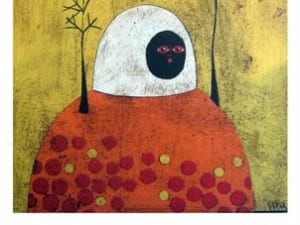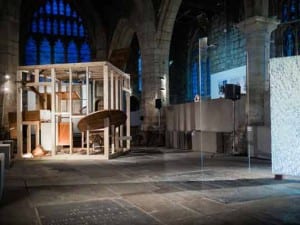James Baldwin once stated, “The power to define the other seals one’s definition of oneself – who, then, in such a fearful mathematic is trapped?” When applied to the work of Fiona Foley, an Australian-born artist who currently resides on Fraser Island (Thoorgine), this statement takes on a new meaning.
Foley’s photographic series entitled HHH (Hedonistic Honky Haters) subverts our (mis)conceptions about race and racial hatred. The HHH series, a group we are told that was formed in 1965 as a reaction to the Ku Klux Klan, are comprised of black males wearing the typical hooded robes of the KKK but in bright, colorful, ethnic fabric (redolent of the Dutch fabric used by Yinka Shonibare in his work). Foley, in response to the suggestion that the group is visually depicted as objects for anthropological study, in much the same way that the Indigenous “primitives” were in images by British colonizers in 19th and 20th century North America, counters that these works are not meant as a rebuttal to colonial images but rather are just a playful, subversive response to the KKK. By choosing the KKK as the source of her work, Foley desacralizes the group and reduces them to a subject of derision and scorn.
Foley, a member of the Badtjala tribe of Fraser Island, has through her work, directed attention to the history of the indigenous people of Australia. Her work, which unconsciously brings notice to the land disputes/claims of the Aborigines, is, for Foley, an attempt to re-write or revise history (a history, which is still being written, with the right to vote for Aboriginal people being granted only in 1967). History, as taught in schools, was and is for the most part, written by colonizers and as a result the history of the indigenous people has been written out. The same is true in the Eurocentric art history pedagogy of Australian art schools, such as the Sydney College of Art where Foley studied. This exclusion, of the indigenous history and culture, is a motivating force in her work. Having grown up with the White Cube gallery and conventional museum, she sees the onus as on the curator, rather than the artist or institution, in exposing the colonial underpinnings of art history. She cites the 2004-2005 exhibition Only Skin Deep as an example of the way in which curators can call attention to such concerns (the exhibit was based upon themes of race, exclusion, and national identity). Foley, who worked as a curator in the early 1990s, made the conscious decision at that time to concentrate on her work as a contemporary artist rather that follow the curatorial route.
Foley, who categorizes herself as a contemporary political artist with a bad girl reputation, utilizes the language of the Badjatala tribe and the environs of Fraser Island as references in her work. The relationship between land and identity is a strong force in her work, evident in works such as the Signpost series (2006) and Samsara I (2003).
Provocative though she may be, Foley succeeds in highlighting issues of memory, history, and race politics: issues that artists such as Fred Wilson, a major source of inspiration for her, address in their own work. The exhibition ran at the October Gallery until 2 December 2006.
Niamh Coghlan





